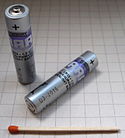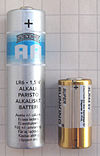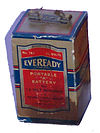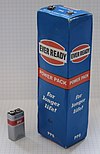Annex: Types of batteries
The battery types are standardized and normalized. }
Cylindrical battery types
(AAA size for scale)- Notes
- The batteries of 6 V, 9 V and 12 V are usually manufactured by multiples of 1.5 V in series. When accumulators are used (NiMH or NiCd), the total voltage is to multiply by 0.83, since each element provides 1.24 V instead of 1.5 V. There are alkaline accumulators supplying 1.5 V.
- The applicable European standard is IEC 60086-1 Primary batteries - Part 1: General (BS397).
- The LR-xx series indicates that they are alkaline batteries. Zinc-carbons do not carry "L": R-6, R-20, etc.
- The applicable American standard is ANSI C18.1 American National Standard for Dry Cells and Batteries-Specifications.
Rectangular batteries
Button type batteries
Zinc air cells (hearing aid)
Zinc Air Hearing Aid Batteries

Miniature zinc-air batteries are button cells that use oxygen in the air as a reagent and have a very high capacity for their size. Each cell needs about 1 cm3 of air per minute at a discharge rate of 10 mA. These cells are commonly used in hearing aids. A sealing tab keeps air stored out of the cell; A few weeks after breaking the seal, the electrolyte will dry out and the battery will be unusable regardless of use. The nominal discharge voltage is 1.2 V.
| Names | Typical
capacity (mAh) | Dimensions
day. × h.(mm) | Comments | |||
|---|---|---|---|---|---|---|
| More common | Another common | IEC | ANSI | |||
| 5 | AC5, ZA5 | PR63 | 7012ZD | 33 | 5.8 × 2.5 | Marked as "discontinued" in Energizer data sheet. |
| 10 | AC10, AC10 / 230, DA10, DA230, ZA10 | PR70 | 7005ZD | 91 | 5.8 × 3.6 | |
| 13 | ZA13 | PR48 | 7000ZD | 280 | 7.9 × 5.4 | |
| 312 | 6135-99-752-3528 (NSN)
ZA312 | PR41 | 7002ZD | 160 | 7.9 × 3.6 | |
| 630 | DA630 | 7007Z | 1,000 | 15.6 × 6.2 | No longer appears on the Duracell list | |
| 675 | ZA675 | PR44 | 7003ZD | 600 | 11.6 × 5.4 | |
| AC41E | PR43 | 7001Z | 390 | 11.6 × 4.2 | Discontinued | |
Lithium ion batteries (rechargeable)

Lithium Ion Size List
(in English)

Unlike the Tesla Model S, Model 70 mm high) lithium ion manufactured in the Reno (Nevada) factory. The 2170 battery is 50% larger in volume than the 18650 and can deliver between 5750 and 6000 mA, while the 18650 only delivers 3000 mA.
The batteries have a very high energy density, because they significantly reduced the cobalt content, while increasing the nickel content, maintaining thermal stability. The cobalt content of the nickel-cobalt-aluminum cathode is lower than that of nickel-manganese-cobalt using a ratio of 8:1:1 used by other manufacturers. The Standard version has 2976 batteries grouped in groups of 31 and the Long Range version has 4416 in groups of 46.
Tesla hopes to produce 2170 batteries at the same cost as 18650, which means a reduction in the price of the battery pack. The battery chemistry has been improved and has a higher energy density. Mass production of the 2170 battery at the factory allows Tesla to achieve economies of scale.
So that the batteries always remain in an optimal temperature range, the Tesla Model 3 has an active liquid cooling system. At the bottom of the front bumper there is a mobile grille that allows the air flow to be regulated to cool the battery. The battery management system is similar to that used by the Tesla Model S and Tesla Model X and achieves greater battery longevity than vehicles that have a passive air cooling system.
List of obsolete batteries
PP series

The PP (Power Pack) was manufactured by Ever Ready in the United Kingdom (Eveready in the United States). It included multicellular carbon-zinc batteries used for portable electronic devices. Most sizes are rare today; however, the PP3 size (and, to a lesser extent, PP8, used in electric fences, and PP9) is readily available. PP4 was cylindrical; all other types were rectangular. Most had pressure terminals as seen in the common PP3 type. These came in two incompatible sizes, as is evident in some of the images below, the larger ones, mostly older, types of batteries such as PP9 are somewhat larger than those of the smaller batteries, such as PP3.
Contenido relacionado
Free radius
Sorting algorithm
Large-scale structure of the universe








































